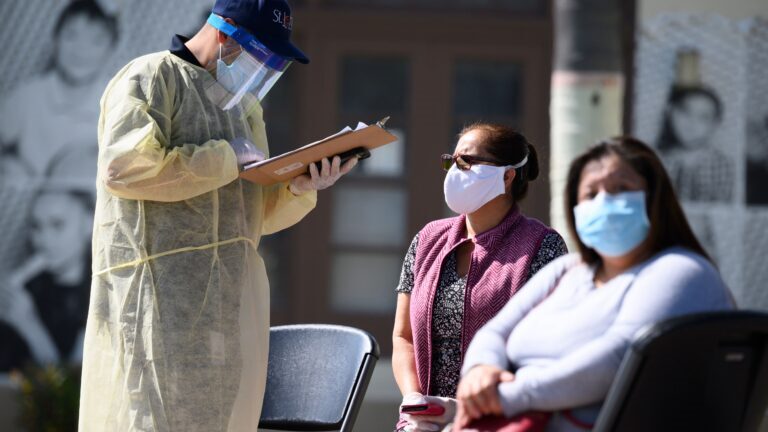In this opinion piece, Kathryn Stephenson, MD (Infectious Diseases, BIDMC) writes on how to ensure that COVID-19 vaccine research includes Black and Latinx participants.
STAT – June 26, 2020
Covid-19 vaccine research must involve Black and Latinx participants. Here are 4 ways to make that happen

ROBYN BECK/AFP via Getty Images
The development of a Covid-19 vaccine is progressing at an incredible pace, breaking down barriers to the invention, manufacture, and testing of potential vaccine candidates. The Department of Health and Human Services says it aims to have “substantial quantities of a safe and effective vaccine available for Americans by January 2021.”
To achieve this goal, each of the five leading Covid-19 vaccine candidates will need to be tested in approximately 30,000 people — a total of 150,000 research participants in the next six months. This will be a massive and unprecedented undertaking.
Equally unprecedented is the opportunity that Covid-19 vaccine development presents to break down barriers to the engagement of Black and Latinx individuals in clinical trials research. Ideally, vaccine trials should include participants from communities that have the highest risk of infection. In the case of Covid-19, those at-risk communities are disproportionately Black and Latinx. To match local demographics of Covid-19, Black or Latinx individuals would need to comprise up to 40% of vaccine trial participants nationwide.
Yet past experience shows that Covid-19 vaccine trials will likely have challenges meeting enrollment targets like these. In 2019, for example, the Food and Drug Administration approved 11 new cancer drugs based on clinical trials that enrolled just 4% of Black participants, despite the fact that Black individuals account for 13% of the U.S. population and have the highest death rate for most cancers.
Most clinical trials are designed to enroll racially and ethnically diverse groups of participants and honestly aim to do that. But it’s a hard goal to achieve. The hours that clinics are open are too limited for people of color whose employers prohibit taking off work; study budgets don’t always pay for interpreters and translations that would facilitate participation by non-English speakers; study protocols often exclude individuals with chronic illnesses like diabetes and hypertension, which disproportionately impact people of color.
The pressure to enroll participants and quickly accumulate data can be intense, especially in a pandemic, often eclipsing the goal of equitable representation.
Another barrier to equitable clinical trial participation is the pervasive structural racism that is intricately woven into the fabric of our society. The U.S. has a shameful history of unethical experimentation on Black men and women, from experimental surgeries performed without anesthesia on enslaved Black women to the misappropriation of cervical tissue from Henrietta Lacks and the infamous Tuskegee syphilis study. This history has led to understandable and pervasive mistrust of clinical research. It is no wonder that Black and Latinx patients often say to us, “I don’t want to be a guinea pig in your experiments.”
Layered on top of this are strong anti-immigrant and sometimes xenophobic views that keep Latinx individuals and others who weren’t born in the U.S. away from contact with health care institutions, including research groups.
A recent survey conducted by the Pew Research Center demonstrates how this sordid history and ongoing structural inequity could affect clinical trial participation: Even if a Covid-19 vaccine were available today and proven effective, only 54% of Black adults would be willing to take it, compared to 74% of white adults. The statistics would likely be equally dismal for participation in Covid-19 vaccine trials.
Everyone in medical research shares the responsibility to promote equitable representation in Covid-19 vaccine trials. Here are some ways we can do this:
Step 1. Acknowledge the problem. We must recognize the importance of enrolling Black and Latinx participants in these studies, even in the context of unprecedented rapid enrollment. Studies must report the demographics of trial enrollment while they are ongoing.
Step 2. Provide appropriate funding to trial sites to support diversity initiatives. It takes money to translate informed consent forms, reimburse participants for transportation, staff clinics on weekends and nights, and advertise in a broad array of neighborhoods and media outlets. It also takes money and institutional will to build a diverse research workforce that reflects affected communities and is representative of the country as a whole.
Step 3. Address research mistrust by engaging communities now, at the beginning, not when it’s time to share the final results. This means investigators need to meet with local stakeholders in Black and Latinx communities, host webinars and virtual town halls, do interviews on community radio, and put themselves out there on social media.
Step 4. Pay people back for trusting in the medical research community. We need to make any successful Covid-19 vaccine that comes out of this herculean research effort accessible to everyone in this country — regardless of race, ethnicity, or the ability to pay for it. The fair and transparent distribution of an effective Covid-19 vaccine is paramount.
Vaccines can be transformative. They have the potential to provide medical shelter against deadly diseases like Covid-19, allowing communities to safely emerge from this pandemic and rebuild.
The recent protests against racism in the United States are calls to medicine and science too: Black and Latinx communities must be a part of the critical endeavor to develop a vaccine for Covid-19.
Kathryn Stephenson is the director of the clinical trials unit in the Center for Virology and Vaccine Research and an infectious disease physician at Beth Israel Deaconess Medical Center in Boston. Bisola Ojikutu is the director of the Community Engaged Research Program in the Harvard Center for AIDS Research and an infectious disease physician at Brigham and Women’s Hospital and Massachusetts General Hospital.

